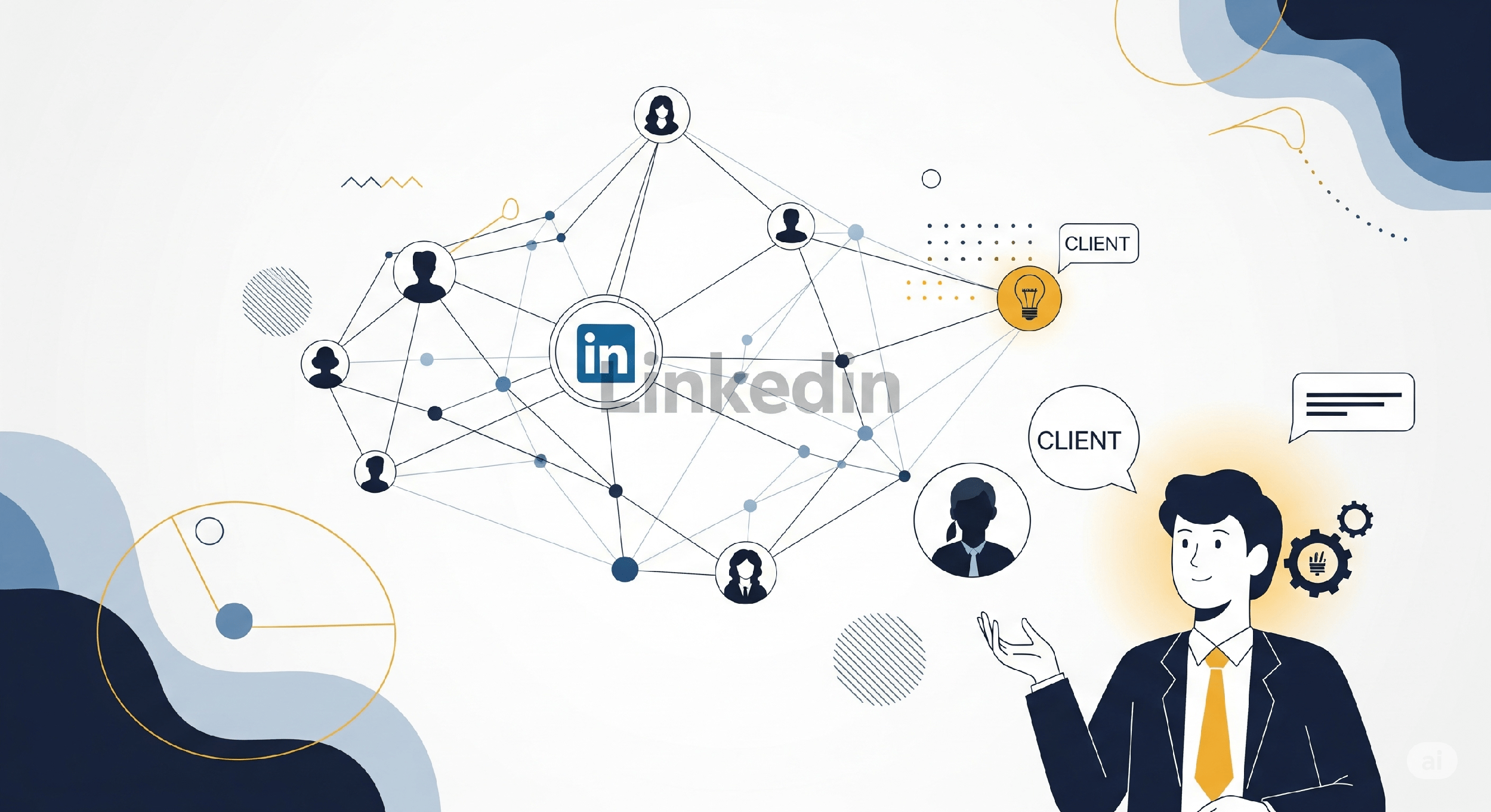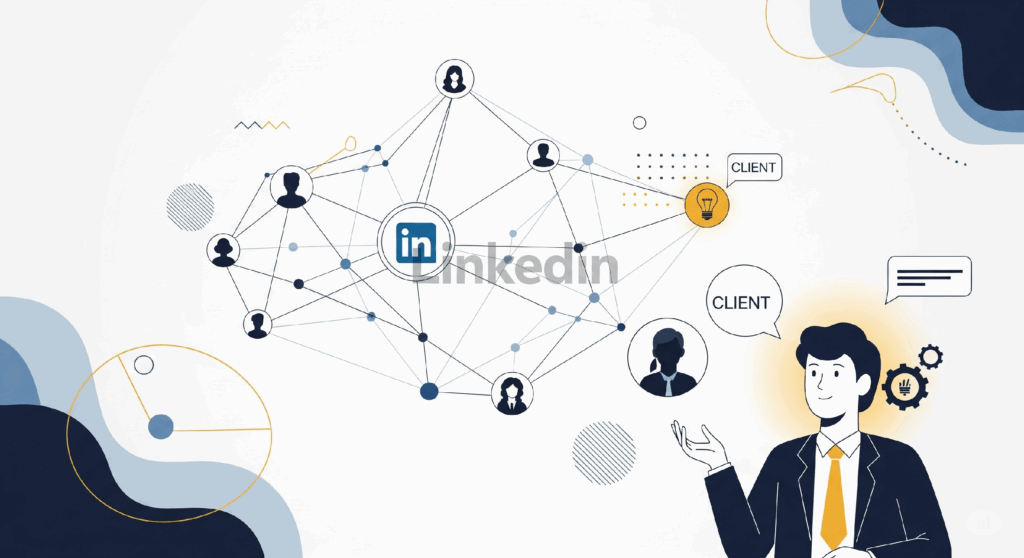This post is also available in:
Let’s play a quick game. Open LinkedIn right now. How many connection requests from complete strangers are sitting in your inbox? How many of them have a generic, copy-pasted message that goes something like this?
“Hi [Your Name], I see we share some common interests. I help companies like yours achieve [Vague Benefit] with my [Amazing Product]. Can we connect for a quick 15-minute demo?”
You delete them without a second thought. We all do.
Now, here’s the tougher question: how many of your own team’s sales messages look exactly like that?
In the world of high-ticket B2B services, this “connect and pitch” strategy isn’t just ineffective; it’s actively damaging your brand. Your ideal clients—the C-suite executives, founders, and key decision-makers—have built-in spam filters that are more advanced than any email client. They are time-poor, inundated with pitches, and can spot a self-serving agenda from a mile away.
So, how do you break through the noise? How do you get the attention of clients who could be worth six or seven figures to your business?
You stop selling. And you start solving.
The single most powerful, yet underutilized, asset you have for attracting high-value clients is not your sales funnel or your ad budget. It’s your personal brand. Specifically, it’s the authority and trust you build through your personal brand on LinkedIn. This article is your blueprint for transforming your LinkedIn presence from a digital resume into a client-attraction machine that works for you 24/7.
The Foundational Mindset Shift: From “Attractive Character” to “Trusted Advisor”
Marketing guru Russell Brunson talks extensively about the “Attractive Character”—a persona that draws people into your world. For the B2B C-suite, this concept needs a sophisticated upgrade. They aren’t looking for a charismatic influencer; they are looking for a Trusted Advisor.
A Trusted Advisor doesn’t chase; they attract. They don’t pitch; they diagnose. They don’t sell services; they provide solutions, often for free, long before a contract is ever discussed.
This is the fundamental mindset shift: Your goal on LinkedIn is not to sell, but to become the number one, go-to resource in your niche. When a high-value prospect has a problem you can solve, your name should be the first one that comes to their mind.
This isn’t just good theory; it’s essential for modern SEO and AI-driven search. When a CEO asks Google’s AI Overview or Gemini, “Who is the top expert in [your field] in [your region]?”, the answer is determined by signals of E-E-A-T (Experience, Expertise, Authoritativeness, and Trustworthiness). A powerful personal brand is the most potent E-E-A-T signal you can create.
Pillar 1: Architecting Your Profile for Authority
Your LinkedIn profile is not your resume. It’s your most important landing page. Before anyone reads your content or accepts your connection request, they will scan your profile. It needs to scream “authority” and “value” in under five seconds.
1. The Banner & Headshot: Your Digital First Impression
- Headshot: Professional, high-resolution, looking at the camera. You should appear approachable and confident. No vacation photos or cropped group pictures.
- Banner: This is your digital billboard. Don’t waste it on a generic cityscape. Use it to convey your value proposition. Include your company logo and a clear, concise statement of the result you deliver.
- Bad: A picture of your office building.
- Good: “Helping SaaS Companies Scale from $10M to $50M ARR with Strategic Financial Modeling.”
2. The Headline: The Most Important Sentence You’ll Write
Your headline is not your job title. It’s a promise. It should answer your ideal client’s silent question: “What’s in it for me?”
Use a simple formula: I help [Your Ideal Client] achieve [Their Desired Outcome] through [Your Unique Mechanism].
- Before: “CEO at Acme Consulting”
- After: “I help B2B Founders secure Series A funding by building investor-ready financial models and growth strategies.”
3. The “About” Section: Your Origin Story & Value Proposition
This is where you apply Russell Brunson’s “Epiphany Bridge” framework. Don’t just list your accomplishments. Tell a story that builds connection and demonstrates your expertise.
Structure your “About” section like this:
- The Hook: Start with the core problem your clients face. Show them you understand their world.
- “Most executive search firms focus on filling a role. They fail to solve the real problem: the catastrophic cost of a bad C-suite hire.”
- The Origin Story: Briefly share your “epiphany”—the moment you discovered the unique way you solve this problem. This builds credibility and humanizes you.
- “After 15 years in corporate HR, I saw firsthand that the most successful hires weren’t about resumes; they were about deep cultural and strategic alignment. I left to build a new model based on a proprietary 360-degree alignment framework…”
- The Value Proposition: Clearly state what you do and for whom.
- “Today, I use that framework to help visionary companies hire the top 1% of talent, de-risking their growth and ensuring long-term success.”
- The Call to Action: Don’t ask for a sales call. Invite them to consume more of your value.
- “I share my insights on hiring, leadership, and culture here on LinkedIn. Follow me for weekly content or download my free ‘C-Suite Retention Playbook’ in the Featured section below.”
4. The “Featured” Section: Your Content Library
This is where you showcase your best “Pillar Content”—high-value assets that prove your expertise. Link to:
- Your best articles or blog posts.
- Podcast or video interviews where you are the expert.
- A downloadable PDF guide, report, or case study.
- A link to your newsletter.
Your profile is now a resource hub, not a resume. It’s designed to pull people in, not just report on your past.
Pillar 2: The Content Engine: Giving Away Your Best Ideas
If your profile is the landing page, your content is the traffic. Consistent, high-value content is how you build trust at scale. To do this without spending all day writing, use the Hook-Story-Offer framework for every post.
The Hook: Stop the Scroll
The first line of your post is the only thing most people will see. It must be compelling enough to make them click “…see more.”
- Use a Contrarian Take: “Stop setting goals. Do this instead.”
- Ask a Provocative Question: “What if your biggest business strength is actually your biggest liability?”
- Share a Startling Statistic: “90% of startups fail. But not for the reason you think.”
- Make a Bold Declaration: “Here’s the single best piece of business advice I’ve ever received.”
The Story: Build Connection & Deliver Value
This is the body of your post. Share a personal experience, a client success story, a lesson learned from a failure, or a simple, actionable framework. Keep paragraphs short (1-2 sentences) and use bullet points or numbered lists for readability. The goal is to teach, not to preach.
The Offer: The Call to Engagement
The “offer” in a LinkedIn post is rarely a product. It’s an invitation to engage.
- Ask a question: “What’s your take on this? Leave a comment below.”
- Drive to other content: “I wrote a full article on this topic. Link in the comments.”
- Encourage sharing: “If you found this valuable, share it with your network.”
Content Mix for the Trusted Advisor:
- 40% Actionable Frameworks & How-To’s: Give away your process. Teach people how to solve a small piece of their problem.
- 30% Contrarian Insights & Point of View: Show you are a leader who thinks differently. Challenge a common industry assumption.
- 20% Case Studies & Client Stories: Prove your methods work in the real world. Frame it as “Here’s how my client achieved X” not “Look how great I am.”
- 10% Personal Stories & Lessons Learned: Humanize your brand. Share a relevant personal story that connects to a business lesson.
Pillar 3: Engagement & Nurturing: Building Relationships, Not Lists
Content is only half the battle. The real magic happens in the comments and your inbox.
- The 15-Minute Rule: Spend 15 minutes every day engaging with others. Leave thoughtful, insightful comments on posts from your “Dream 100″—your ideal clients and industry peers. A good comment is a mini-post in itself.
- Respond to Every Comment: When people take the time to comment on your posts, honor it with a thoughtful reply. This builds community and dramatically increases your post’s reach.
- Move Conversations to the DM, Strategically: When someone leaves a particularly insightful comment or asks a deep question, respond publicly and then follow up with a DM.
- The Wrong Way: “Thanks for the comment! Can I show you a demo of my product?”
- The Right Way: “That was a really insightful point you made about [topic] in my post. It got me thinking. I actually have a report on that exact issue I’d be happy to send over if you’re interested. No strings attached.”
You are offering more value, not asking for a sale. This is how you build a pipeline of high-value prospects who see you as a resource long before they ever see a proposal.
Conclusion: Your Brand is Your Business
Building a personal brand on LinkedIn is not a “nice to have” for B2B leaders anymore. It is the most effective strategy for attracting high-value clients in a crowded, skeptical market.
By shifting your mindset from selling to solving, you change the entire dynamic. You stop chasing leads and start attracting clients. You transform your profile from a static resume into a dynamic resource hub. You turn your content into a trust-building engine that works for you while you sleep.
This approach requires consistency and a genuine desire to help your audience. But the payoff is immense: a steady stream of inbound leads who are already convinced of your expertise and are eager to work with you. You’ll spend less time prospecting and more time closing deals with clients who are the perfect fit for your business.
So, what is the one thing you can change on your LinkedIn profile today to better reflect your role as a Trusted Advisor? Share your commitment in the comments below!

